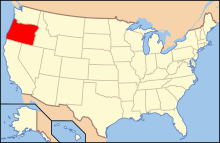

Paleontology in Oregon refers to paleontological research occurring within or conducted by people from the U.S. state of Oregon. Oregon's geologic record extends back approximately 400 million years ago to the Devonian period, before which time the state's landmass was likely submerged under water. Sediment records show that Oregon remained mostly submerged until the Paleocene period. The state's earliest fossil record includes plants, corals, and conodonts. Oregon was covered by seaways and volcanic islands during the Mesozoic era. Fossils from this period include marine plants, invertebrates, ichthyosaurs, pterosaurs, and traces such as invertebrate burrows. During the Cenozoic, Oregon's climate gradually cooled and eventually yielded the environments now found in the state. The era's fossils include marine and terrestrial plants, invertebrates, fish, amphibians, turtles, birds, mammals, and traces such as eggs and animal tracks.
Oregon has a long tradition of paleontological research. Local Native Americans devised myths to explain fossils. By the mid-19th century local fossils had come to the attention of formally trained scientists, and modern research has produced data on climate change and extinction.
The Oligocene dawn redwood Metasequoia occidentalis is the Oregon state fossil.
Prehisto Precambrian There are no known rocks in Oregon from Precambrian times. Geologists infer that the area now occupied by Oregon must have been submerged deep on the ocean floor during that period.[1]

- ^ Fremd, Ted; Retallack, Gregory; Springer, Dale; Scotchmoor, Judy (2005). "The Paleontology Portal: Oregon, U.S." paleoportal.org. Retrieved May 18, 2017.